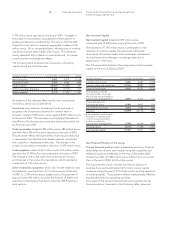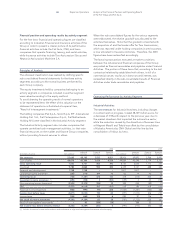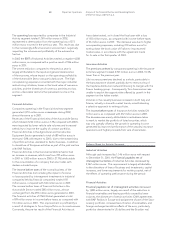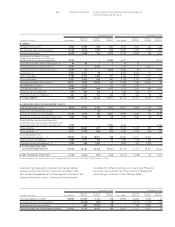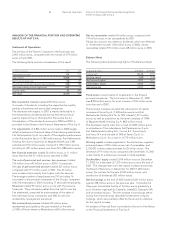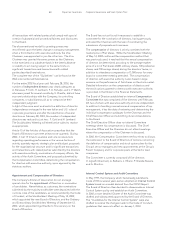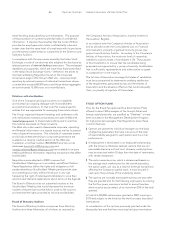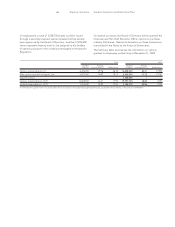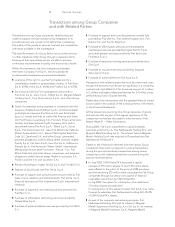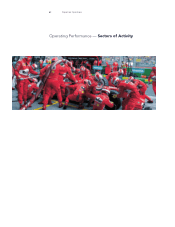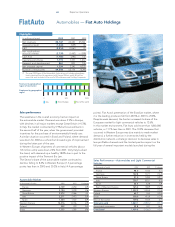Chrysler 2002 Annual Report Download - page 36
Download and view the complete annual report
Please find page 36 of the 2002 Chrysler annual report below. You can navigate through the pages in the report by either clicking on the pages listed below, or by using the keyword search tool below to find specific information within the annual report.
The Audit Committee must be comprised of at least three
independent directors. The mission of the Committee is to
assist the Board of Directors in discharging its own duties
by providing it with advice and proposals on the reliability of
the accounting system and financial information; the Internal
Control System; the choice and supervision of the work of
the independent auditors; and supervision of the activities
of internal auditors.
In particular, the Committee must:
❚assist the Board of Directors with periodic audits of the
appropriate and actual functioning of the Internal Control
System to ensure identification and proper handling of the
principal risks faced by the Company;
❚assess the operating plan prepared by the Supervisors of the
Internal Control System and receive their periodic reports;
❚report to the Board of Directors on the adequacy of the
Internal Control System at least once every six months, at
the time the annual report and first half report are approved;
❚assess the organizational position and ensure the actual
independence of the Supervisors of the Internal Control
System in the performance of their duties in accordance with,
among other things, Legislative Decree no. 231/2001 on the
administrative liability of companies;
❚assess, in collaboration with the Chief Accounting Officer
and the independent auditors: (a) the adequacy of adopted
accounting principles and (b) their uniformity in view of
preparation of the consolidated financial statements;
❚with the assistance of the Chief Accounting Officer and the
Head of Internal Audit, assess the proposals submitted by
candidates for the position of independent auditors and draft
the motion for appointment of the independent auditors to
be submitted by the Board of Directors to the Stockholders’
Meeting;
❚assess the audit operating plan and the results set forth
in the audit report and letter of suggestions;
❚upon recommendation by the Chief Accounting Officer,
grant prior authorization to the independent auditors or
other entities belonging to the auditors’ network to perform
non-auditing activities. In any event, these activities must
be among those allowed under applicable regulations.
The Committee may delegate one or more of its members
to grant such prior authorization, enjoining the delegated
member to report at its next meeting;
❚assess the position and organizational structure of Internal
Audit and its work plan.
The Committee shall meet on convocation by its Chairman
whenever he deems it appropriate, but at least once every six
months, or whenever the Chairman of the Board of Statutory
Auditors or the Supervisors so request. The Chairman of the
Board of Statutory Auditors, or another Statutory Auditor duly
empowered by the Chairman, and the Supervisors shall
participate at Committee meetings.
The directors with executive authority, the independent
auditors, the Chief Accounting Officer, and possible other
parties shall participate at Committee meetings on invitation
by the Committee Chairman. The Committee shall meet in
the absence of the directors with executive authority at least
twice each fiscal year.
This Committee is currently comprised by three Directors:
A. Benessia (Chairman), F. Cotti, and H. Lamberti.
The Board of Directors appoints the Supervisors of the Internal
Control System. In the course of performing their duties, they
are not subject to the jurisdiction of operating managers but
instead report directly to the Chief Executive Officer, the Audit
Committee, and the Board of Statutory Auditors. At present,
the Supervisors of the Internal Control System are the General
Counsel and the Chief Accounting Officer. They rely on input
from the Internal Audit function, which is performed for the
entire Group by Fiat Revi, a highly skilled and capable
consortium company.
The most important initiatives pursued in 2002 by the
Committee and the Supervisors included complete revision
of the Group’s corporate governance tools (Guidelines for
the Internal Control System, Charter of the Audit Committee,
Guidelines for Significant Transactions and Transactions with
Related Parties, Internal Dealing Regulation), in particular the
new Code of Conduct that replaces the Code of Ethics.
This document was approved by the Board of Directors at the
end of 2002 and established the necessary basis for drafting
of the Compliance Program adopted by the Board of Directors
on February 28, 2003, pursuant to Legislative Decree no. 231
of June 8, 2001 (Norms Governing the Administrative Liability
of Legal Entities). The Compliance Program of the Fiat Group,
which was drafted in conformity with the guidelines prepared
by Confindustria, is comprised of a General Part and two Special
Parts (Offenses Committed in Relations with Public Agencies,
and White Collar Crimes). Group companies were asked to
adopt the compliance programs in accordance with the rules
and general principles contained in the compliance program
of the Parent Company after identifying the respective sensitive
processes and specific procedures to be developed according
to their particular situations.
Handling of confidential information
The Board of Directors promoted the adoption of an internal
procedure for handling confidential information. This procedure
was published as part of a special organizational announcement
by the Chief Executive Officer. It lists the different types of
confidential information, defines the functions and
responsibilities of those who are charged with handling such
information, and explains the rules that govern the disclosure
of price-sensitive news and the steps that should be followed
34 Report on Operations Corporate Governance and Stock Option Plans



